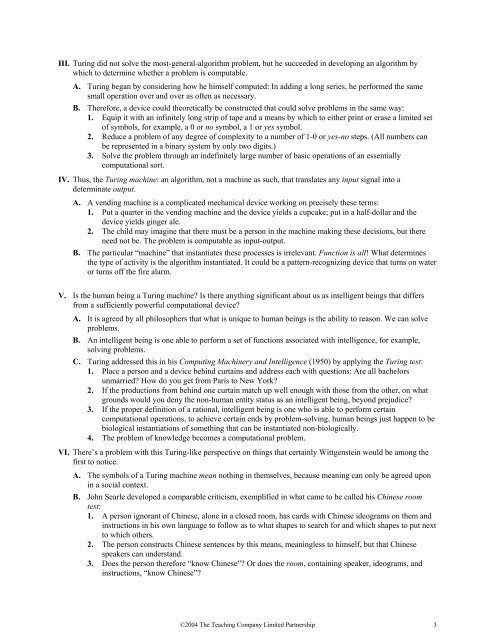Great Ideas of Philosophy
Great Ideas of Philosophy
Great Ideas of Philosophy
- No tags were found...
Create successful ePaper yourself
Turn your PDF publications into a flip-book with our unique Google optimized e-Paper software.
III. Turing did not solve the most-general-algorithm problem, but he succeeded in developing an algorithm bywhich to determine whether a problem is computable.A. Turing began by considering how he himself computed: In adding a long series, he performed the samesmall operation over and over as <strong>of</strong>ten as necessary.B. Therefore, a device could theoretically be constructed that could solve problems in the same way:1. Equip it with an infinitely long strip <strong>of</strong> tape and a means by which to either print or erase a limited set<strong>of</strong> symbols, for example, a 0 or no symbol, a 1 or yes symbol.2. Reduce a problem <strong>of</strong> any degree <strong>of</strong> complexity to a number <strong>of</strong> 1-0 or yes-no steps. (All numbers canbe represented in a binary system by only two digits.)3. Solve the problem through an indefinitely large number <strong>of</strong> basic operations <strong>of</strong> an essentiallycomputational sort.IV. Thus, the Turing machine: an algorithm, not a machine as such, that translates any input signal into adeterminate output.A. A vending machine is a complicated mechanical device working on precisely these terms:1. Put a quarter in the vending machine and the device yields a cupcake; put in a half-dollar and thedevice yields ginger ale.2. The child may imagine that there must be a person in the machine making these decisions, but thereneed not be. The problem is computable as input-output.B. The particular “machine” that instantiates these processes is irrelevant. Function is all! What determinesthe type <strong>of</strong> activity is the algorithm instantiated. It could be a pattern-recognizing device that turns on wateror turns <strong>of</strong>f the fire alarm.V. Is the human being a Turing machine? Is there anything significant about us as intelligent beings that differsfrom a sufficiently powerful computational device?A. It is agreed by all philosophers that what is unique to human beings is the ability to reason. We can solveproblems.B. An intelligent being is one able to perform a set <strong>of</strong> functions associated with intelligence, for example,solving problems.C. Turing addressed this in his Computing Machinery and Intelligence (1950) by applying the Turing test:1. Place a person and a device behind curtains and address each with questions: Are all bachelorsunmarried? How do you get from Paris to New York?2. If the productions from behind one curtain match up well enough with those from the other, on whatgrounds would you deny the non-human entity status as an intelligent being, beyond prejudice?3. If the proper definition <strong>of</strong> a rational, intelligent being is one who is able to perform certaincomputational operations, to achieve certain ends by problem-solving, human beings just happen to bebiological instantiations <strong>of</strong> something that can be instantiated non-biologically.4. The problem <strong>of</strong> knowledge becomes a computational problem.VI. There’s a problem with this Turing-like perspective on things that certainly Wittgenstein would be among thefirst to notice.A. The symbols <strong>of</strong> a Turing machine mean nothing in themselves, because meaning can only be agreed uponin a social context.B. John Searle developed a comparable criticism, exemplified in what came to be called his Chinese roomtest:1. A person ignorant <strong>of</strong> Chinese, alone in a closed room, has cards with Chinese ideograms on them andinstructions in his own language to follow as to what shapes to search for and which shapes to put nextto which others.2. The person constructs Chinese sentences by this means, meaningless to himself, but that Chinesespeakers can understand.3. Does the person therefore “know Chinese”? Or does the room, containing speaker, ideograms, andinstructions, “know Chinese”?©2004 The Teaching Company Limited Partnership 3














